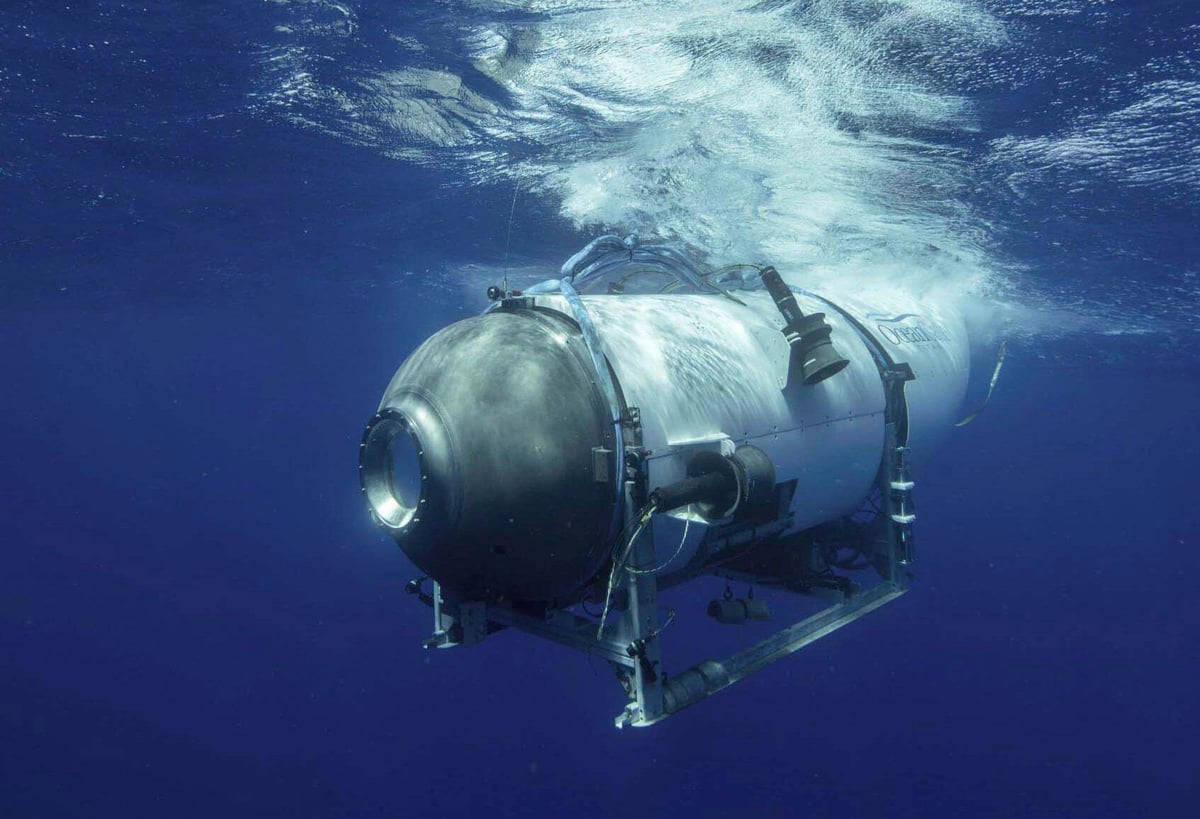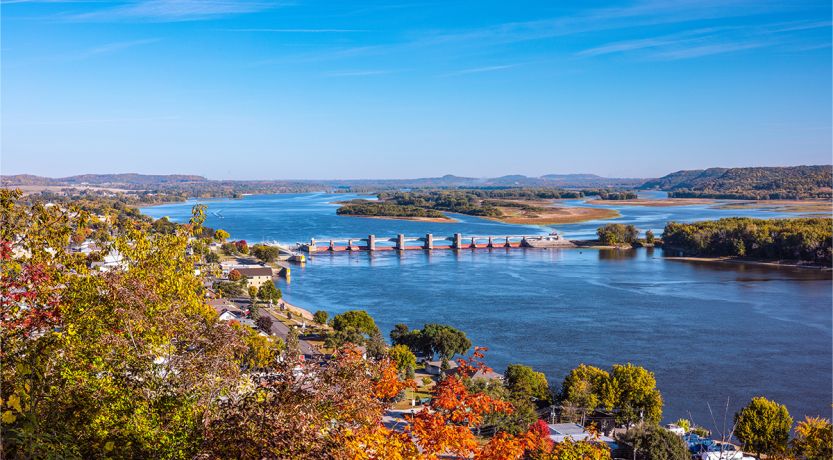.
 Three Lessons From the Titan Tragedy
Three Lessons From the Titan Tragedy
“The loss of the Titan submersible holds many lessons for Christians today. It is a vivid reminder of where our priorities in life need to be.
On June 18, what started as a routine exploration of the infamous Titanic shipwreck turned deadly. During its dive to the bottom of the North Atlantic, the submersible Titan lost communication and went missing.
Rescuers arrived as quickly as possible to assist in locating the submersible some 12,000 feet below the ocean’s surface.
For four days, the world held its breath and hoped for a miraculous rescue.” Continue Reading
From: https://lifehopeandtruth.com/prophecy/blog/three-lessons-from-the-titan-tragedy/?
_________
Was the United States of America Blessed in Its Geography?
 “Geography can appear a bit simplistic on the surface. But what happens when we look a little deeper? Was God involved?
“Geography can appear a bit simplistic on the surface. But what happens when we look a little deeper? Was God involved?
On July 4, the United States of America—the world’s most dominant economic and military power—celebrates its Independence Day. This marks the historic date in 1776 when the Declaration of Independence was approved by its Continental Congress.
Although U.S. leadership is being challenged on many fronts, this nation remains one of the leading countries where migrants wish to settle. It is respected as the premier land of personal freedoms and economic opportunity.
But it also evokes hatred among some for the way it has used its power. And also envy, especially from large nations, such as Russia and China, that aspire to global dominance themselves.
The largest nations according to land mass
When one considers the basic geographical features of the U.S. compared to other nations, the facts are pretty basic. In terms of size, Worldometers.info lists the U.S. as the fourth-largest country in the world—just over half the total area of Russia, which is by far the largest country. Canada, the second-largest, and China, the third-largest, have just slightly more territory than the U.S.
If all geography were equal, the nation with the most real estate should lead the world in pretty much everything, and the other nations should fall in line according to their size. But as we will see, not all geography is equal.
The largest nations by population
Before proceeding, we should note that some might wonder if population matters when it comes to determining a nation’s prominence. Worldometers.info lists China as the most populous nation, with a population of more than 1.4 billion, representing 18.5 percent of the world’s population. However, the United Nations predicts that this year India will pass China to become the world’s most populous nation.
Russia, which has the most land, has only the ninth-largest population.
The U.S. is the third-most-populous country, with 331 million people, a pittance in comparison to China and India, and accounts for just over 4 percent of the world’s population. Population clearly isn’t the primary driver of a nation’s prominence.
Geography, on the other hand, makes a huge difference.
Blessed with navigable waterways
To understand how geography helped America become an economic powerhouse, we need to drop back a couple of centuries to note the effect navigable waterways had on agriculture and transportation.
God did not give the people of the United States of America all these blessings so they could simply enjoy their wealth, while forgetting God and exploiting others. God will hold Americans accountable for their sins and for not being a godly example to others.
Prior to the industrial age and globalization, the high cost of transportation limited trade and the growth of cities. Unless a commodity had high value, low bulk and was nonperishable, there was little incentive to move it very far. Transporting a relatively inexpensive item long distances could cost more than the product itself. Most trade was generally local, and cities were limited in size when all the food had to be procured nearby.
But costs plummeted when goods were transported via water. Transporting goods on water has been estimated to use 12 times less energy than doing so on land.
The U.S. is immensely blessed with an abundance of navigable inland waterways. Foreign affairs analyst Tim Marshall in his book Prisoners of Geography explains it like this: “The greater Mississippi basin [in the U.S.] has more miles of navigable river than the rest of the world put together. Nowhere else are there so many rivers whose source is not in highland and whose waters run smoothly all the way to the ocean across vast distances.
“The Mississippi, fed by much of the basin river system, begins near Minneapolis and ends 1,800 miles south in the Gulf of Mexico. So the rivers were the natural conduit for ever-increasing trade, leading to a great port and all using waterborne craft that was, and is, many times cheaper than road travel” (pp. 68-69).
And having a river nearby to irrigate crops is also of tremendous benefit when rain is scarce.
Blessed with abundant farmland
When it comes to raising crops, not all land is equally productive. Russia and Canada, for example, have much land in frigid climates that is not as productive as land in temperate climates. Compared to the other larger countries in the world, the U.S. has the bulk of its agricultural real estate in latitudes that are optimal for growing food.
“The United States has more high-quality, temperate-zone, arable farmland than any other country and its entire agricultural supply chain is contained within North America. This makes the United States the world’s largest agricultural producer and exporter” (The End of the World Is Just the Beginning, Peter Zeihan, p. 89).
Blessed with abundant energy
With its abundant natural resources, the U.S. is capable of energy independence. The shale revolution allowed the U.S. to become the world’s largest oil producer. It easily has the potential to supply all of its own needs and export the excess. Using fossil fuels, natural gas and coal, the U.S. has “the lowest unsubsidized electricity costs in the world” (p. 90).
The U.S. is the second-largest solar energy producer in the world. As well, “the positioning of its mountains compared to its coasts gives it more wind power potential than any other country” (p. 90).
Blessed with natural security boundaries
In regard to security, the fewer nations a country has on its borders, the easier it can be to remain at peace. Geography can be of great help as well. The U.S. has great oceans to its east and to its west that would make it difficult for hostile nations to mount a successful invasion.
This unprecedented degree of security has given the U.S. room to maneuver and even a margin for error in international relations and allowed the country to blossom economically.
Challenging weather because of geography
As a negative, the U.S. experiences some of the worst weather catastrophes in the world because of its geography. Science writer Seth Borenstein says, “Blame geography for the U.S. getting hit by stronger, costlier, more varied and frequent extreme weather than anywhere on the planet . . .
“Two oceans, the Gulf of Mexico, the Rocky Mountains, jutting peninsulas like Florida, clashing storm fronts and the jet stream combine to naturally brew the nastiest of weather” (“Why the U.S. Is Leading the World in Extreme Weather Catastrophes,” April 2, 2023).
God determines the boundaries of nations
Nasty weather aside, some would say the U.S. won the lottery in terms of its geography. But it wasn’t luck that gave the U.S. such choice real estate. The Bible reveals that God determines the boundaries of nations.
In addressing first-century intellectuals in Athens, Paul explained who the God of the Bible is. Among other key facts, Paul noted that God “has made from one blood every nation of men to dwell on all the face of the earth, and has determined their preappointed times and the boundaries of their dwellings” (Acts 17:26).
Occasionally the boundaries of nations change, but God remains the sovereign power. Changes are subject to His will and the actions of the people involved (Deuteronomy 28:1; 2 Chronicles 20:6; Daniel 4:35).
So why did God give the U.S. so many geographical blessings?
Blessings to Abraham
Those of us producing Discern magazine believe the reason the U.S. has so many blessings, including those of geography, goes back to promises God made to Abraham almost 4,000 years ago. We believe the territory of the United States was given to descendants of this ancient patriarch.
While space in this article doesn’t permit a thorough explanation, consider just a few of the things the Bible tells us about the descendants of Abraham.
- God said Abraham’s descendants would grow into a great multitude of people (Genesis 15:5).
- In the end time some of these peoples would become “a multitude of nations” and others a single great nation (Genesis 48:19).
- These peoples who would become a multitude of nations and a great single nation were also promised economic prosperity and military strength (Genesis 49:22-26).
- Moses prophesied the descendants of Joseph would be given immense agricultural blessings that would include “the precious things of heaven, with the dew, and the deep lying beneath . . . with the precious things of the earth and its fullness” (Deuteronomy 33:13, 16).
- God expected Abraham’s descendants to be a godly example and said that He would bless them for obedience to His law and punish them for disobedience (Deuteronomy 28:1, 15).
- Eventually, God will bless all peoples and nations through these people (Genesis 12:1-3).
It’s important to note, however, that God did not give the people of the United States of America all these blessings so they could simply enjoy their wealth, while forgetting God and exploiting others. God will hold Americans accountable for their sins and for not being a godly example to others.” From: https://lifehopeandtruth.com/prophecy/america-in-prophecy/united-states-blessed-in-geography/?
_______
Preventing Wrinkles with Diet
What dietary intervention may significantly protect against wrinkles in the crow’s foot area around the eyes?
Transcript of video at: https://nutritionfacts.org/video/preventing-wrinkles-with-diet/
Below is an approximation of this video’s audio content. To see any graphs, charts, graphics, images, and quotes to which Dr. Greger may be referring, watch the above video.
“Eating healthier can produce healthier skin. But people don’t care about microscopic changes. What about overt, visible-to-the-naked-eye changes?
The extent of facial wrinkles in the crow’s foot area was determined by observation, using the Daniell scale, in 716 women. This is the scoring system they’re talking about; it’s a scale of one through six; six being the worst. So, what seemed to help the most? “In the present study, a higher intake of green and yellow vegetables was associated with decreased facial wrinkling. Those eating less than a serving of green and yellow vegetables averaged a score of three; those eating two or more servings a day, averaged a two.”
What really excited the researchers was the potential for these studies to promote a healthy diet. I mean, eating fruits and vegetables to prevent cancer and heart disease—who cares? But, wrinkles on the other hand…”” From: https://nutritionfacts.org/video/preventing-wrinkles-with-diet/
______
Hi Folks,
I did not have time to post last week, I was very busy moving back to Conroe, TX. Home again!!
______
 “My grandfather was a major influence in my life and impacted what kind of father I became years later. Here’s what I learned from him.
“My grandfather was a major influence in my life and impacted what kind of father I became years later. Here’s what I learned from him. One day, on my way home from work, a back tire blew on my car. Grandpa had taught me how to change a tire, so I jacked up the car and went to work. But the lug nut didn’t want to come off. I figured I would put all my strength into it, but the entire lug bolt twisted off, nut and all! Then I tried another, and got the same result. With only three left, I was in trouble! I walked to the nearest farmhouse to use the phone and called Grandpa.
One day, on my way home from work, a back tire blew on my car. Grandpa had taught me how to change a tire, so I jacked up the car and went to work. But the lug nut didn’t want to come off. I figured I would put all my strength into it, but the entire lug bolt twisted off, nut and all! Then I tried another, and got the same result. With only three left, I was in trouble! I walked to the nearest farmhouse to use the phone and called Grandpa.
 “The vastness and unexplored mystery of outer space has inspired many. But is it truly the final frontier? What other vistas await the human race?
“The vastness and unexplored mystery of outer space has inspired many. But is it truly the final frontier? What other vistas await the human race?
 “The search for life in outer space is not just the stuff of science fiction. Scientists continue to look for evidence of life out there. Will they find it?
“The search for life in outer space is not just the stuff of science fiction. Scientists continue to look for evidence of life out there. Will they find it?










